Source https://www.foodpolitics.com/2018/12/weekend-reading-the-2018-global-nutrition-report/
If you want an overview of the current status of nutrition problems in the world, what is being done about them, and what needs to be done about them, this report is required reading (to get to the download button for the entire report, scroll to the end of the page).
The report is chock full of useful facts, figures, case studies, and recommendations. A massive undertaking, it
was produced by the Independent Expert Group of the Global Nutrition Report, supported by the Global Nutrition Report Stakeholder Group and the Secretariat at Development Initiatives. The writing was led by the co-chairs Jessica Fanzo and Corinna Hawkes, supported by group members and supplemented by additional analysts and contributors.
For a quick overview, go right to the slide deck and then to the graphics in the executive summary.
The report deals both with problems of malnutrition (undernutrition) and obesity (overnutrition), especially in children.
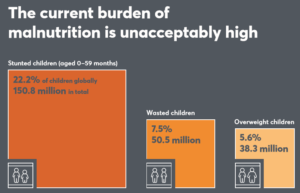 It also deals with adult obesity:
It also deals with adult obesity:
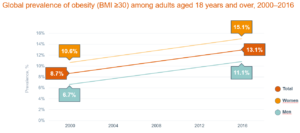
It identifies measurable nutrition indicators that can be used to track progress:
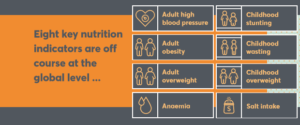
It recommends actions to reduce the prevalence of malnutrition and obesity.
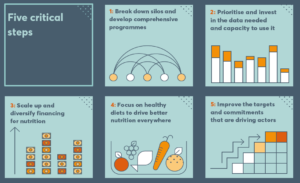
What stands in the way of implementing these steps? Political will, alas.
These reports have come out annually since 2014. Let’s hope this one gets the attention it deserves.
Source https://www.foodpolitics.com/2018/12/weekend-reading-the-2018-global-nutrition-report/
If you want an overview of the current status of nutrition problems in the world, what is being done about them, and what needs to be done about them, this report is required reading (to get to the download button for the entire report, scroll to the end of the page).
The report is chock full of useful facts, figures, case studies, and recommendations. A massive undertaking, it
was produced by the Independent Expert Group of the Global Nutrition Report, supported by the Global Nutrition Report Stakeholder Group and the Secretariat at Development Initiatives. The writing was led by the co-chairs Jessica Fanzo and Corinna Hawkes, supported by group members and supplemented by additional analysts and contributors.
For a quick overview, go right to the slide deck and then to the graphics in the executive summary.
The report deals both with problems of malnutrition (undernutrition) and obesity (overnutrition), especially in children.
 It also deals with adult obesity:
It also deals with adult obesity:

It identifies measurable nutrition indicators that can be used to track progress:

It recommends actions to reduce the prevalence of malnutrition and obesity.

What stands in the way of implementing these steps? Political will, alas.
These reports have come out annually since 2014. Let’s hope this one gets the attention it deserves.
Source https://www.niashanks.com/never-have-bad-luck-again/
 Would you rather listen to this article? Use the player below, download it, or use iTunes.
Would you rather listen to this article? Use the player below, download it, or use iTunes.
We interrupt your regularly scheduled article filled with practical strength training and nutrition information to help you build a healthier body without resorting to miserable dieting tactics or grueling workouts to bring you this important message about bad luck, soggy hiking boots, and a bit of optometry.
Imagine for a moment you and I are going on a hike together on a midsummer afternoon. We choose a trail that cuts through a thick forest.
As we begin, I comment on the remnants of trash littering the entrance of the trail. “Stupid people who are too lazy to throw away their garbage,” I grumble. Minutes later I point out the poison ivy that edges the trail, and then the venomous snake sunbathing a few yards past that and say, “Ugh, I hate snakes and poison ivy. Those could ruin this day quickly.”
An hour into the hike the trails winds through the pine needle covered forest floor and I remark on the suffocating humidity, scorching sun, the thorns that tear into my shins, the blister forming on my left heel, and the fatigue setting in. We approach a swollen stream and cautiously tip-toe across on the exposed rocks. Despite our efforts we both slip and have a foot submerge into the water. “What else could go wrong!” I fuss as I shake the excess water out of my soggy boot.
I am, apparently, miserable. But not you. A smile has been glued to your face since the hike began.
When I saw garbage littering the trail head, you spotted flowers blooming in the sunshine squeezing between the trees. When I whined about the poison ivy and snake you filled your lungs with fresh air and watched a hawk soar above the treetops. When I bellyached about the oppressive humidity and heat you soaked in midsummer’s beauty and her bounty. While I complained about getting tired and my blister collection and scrapes, you welcomed the invigorating challenge. When I was cursing my soggy boot, you kept walking and laughed with each squish of your saturated foot.
And there we were. Two people on the same trail, in the same situation. Yet each of us had two remarkably different experiences. It’s almost like we hiked two different trails.
We’ve all known someone (maybe we are that someone) who claims to be the recipient of never-ending bad luck. It’s like the world singled them out because terrible things always happen to them … so they boldly claim. They get sick; their car breaks down; the air conditioner goes out in the middle of summer on a holiday weekend; their team lost the big game; someone took the last piece of cake at work; they get a nagging injury when they finally start working out. “This stuff always happens to me” is their motto. They fancy themselves a bad-luck magnet.
Break the Bad Luck Streak
Regardless of the choices we face or the events that happen throughout the day, we have two lenses we can choose to view them from. In one hand is the lens that distorts events as being “bad luck” or “shit” or “unfortunate.” In the other hand is the lens that homes in on what has happened, what is — free from distortion or distraction — and gives us the power to glimpse and choose to see “beauty” or “good” or, at the very least, reality. Without any messy extrapolation.
There was a time I frequently viewed events through the “shit” lens. Words like “suck” and “dislike” and “bad luck” and others with a negative connotation would pass my lips. Then I got a little older, a smidge wiser, and realized I could choose which lens to look through. With awareness and practice, I stopped picking up the “bad luck” lens and began choosing to see the good things.
Recommended article: You Owe It to Yourself to Give Fewer Shits
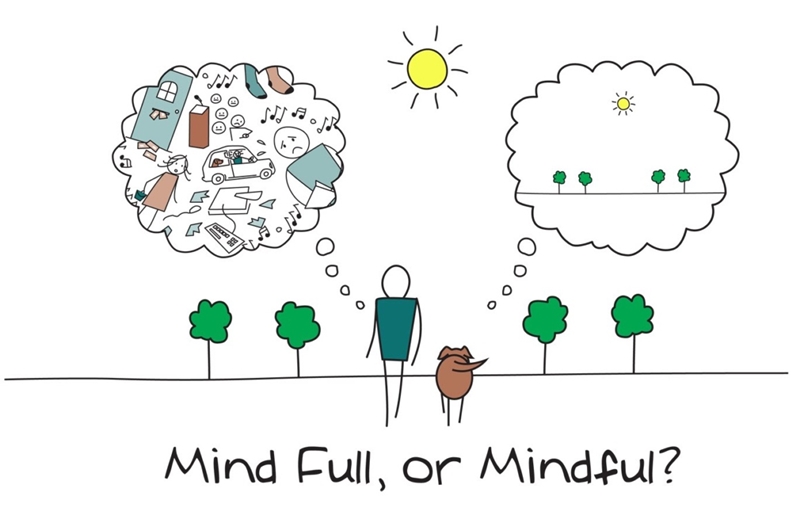 A funny thing happens when we choose to look for the good, the beautiful things. We can see them everywhere, even in unexpected circumstances. Likewise, if we typically laser in on the bad or unfortunate things, we can avert our gaze and look elsewhere or, more simply, erase the “bad luck” or “unfortunate” labels we assign to them.
A funny thing happens when we choose to look for the good, the beautiful things. We can see them everywhere, even in unexpected circumstances. Likewise, if we typically laser in on the bad or unfortunate things, we can avert our gaze and look elsewhere or, more simply, erase the “bad luck” or “unfortunate” labels we assign to them.
Bad Luck and Fitness
This website is dedicated to providing health and fitness information that doesn’t suck. You may think this article is a departure from that goal, but you’d be wrong. The same mentality discussed above — choosing which lens to view events — can, and should be, applied to health and fitness.
Did you have a “bad” workout, or was showing up and getting it done a victory?
Did you “fail” when you ate pizza and ice cream and blew past your allotted caloric intake for the day, or did you have a great time socializing and enjoying your favorite foods knowing you’ll get back on track with the next meal?
Recommended article: One Simple Hack to Stop Screwing Yourself Over
Do you have a nagging ache or injury that’s preventing you from working out the way you’re accustomed to, or is this an opportunity to focus on what you can do and improve in exercises/areas you otherwise wouldn’t?
Did you “let yourself go” and gain excess weight over the years and now find yourself hating your body, or are you seeing the compounding effects of previous years of choices and now know you can start walking in a more healthful and rewarding direction?
Do you typically exercise to punish yourself for overeating or for having fat on your body, or will you choose to exercise to make yourself stronger and healthier and a better version of yourself?
No matter what situation you face today, tomorrow, the day after, you will have the choice of viewing the situation from one of two lenses. Which one will you hold in front of your eyes? What will you choose to see?
While you’re here, subscribe to the newsletter. You’ll receive a short email course to jump start your health and fitness journey, and you’ll get insider-only information. Enter your email below.
The post Never Have “Bad Luck” Again appeared first on Nia Shanks.
Source https://www.niashanks.com/never-have-bad-luck-again/
 Would you rather listen to this article? Use the player below, download it, or use iTunes.
Would you rather listen to this article? Use the player below, download it, or use iTunes.
We interrupt your regularly scheduled article filled with practical strength training and nutrition information to help you build a healthier body without resorting to miserable dieting tactics or grueling workouts to bring you this important message about bad luck, soggy hiking boots, and a bit of optometry.
Imagine for a moment you and I are going on a hike together on a midsummer afternoon. We choose a trail that cuts through a thick forest.
As we begin, I comment on the remnants of trash littering the entrance of the trail. “Stupid people who are too lazy to throw away their garbage,” I grumble. Minutes later I point out the poison ivy that edges the trail, and then the venomous snake sunbathing a few yards past that and say, “Ugh, I hate snakes and poison ivy. Those could ruin this day quickly.”
An hour into the hike the trails winds through the pine needle covered forest floor and I remark on the suffocating humidity, scorching sun, the thorns that tear into my shins, the blister forming on my left heel, and the fatigue setting in. We approach a swollen stream and cautiously tip-toe across on the exposed rocks. Despite our efforts we both slip and have a foot submerge into the water. “What else could go wrong!” I fuss as I shake the excess water out of my soggy boot.
I am, apparently, miserable. But not you. A smile has been glued to your face since the hike began.
When I saw garbage littering the trail head, you spotted flowers blooming in the sunshine squeezing between the trees. When I whined about the poison ivy and snake you filled your lungs with fresh air and watched a hawk soar above the treetops. When I bellyached about the oppressive humidity and heat you soaked in midsummer’s beauty and her bounty. While I complained about getting tired and my blister collection and scrapes, you welcomed the invigorating challenge. When I was cursing my soggy boot, you kept walking and laughed with each squish of your saturated foot.
And there we were. Two people on the same trail, in the same situation. Yet each of us had two remarkably different experiences. It’s almost like we hiked two different trails.
We’ve all known someone (maybe we are that someone) who claims to be the recipient of never-ending bad luck. It’s like the world singled them out because terrible things always happen to them … so they boldly claim. They get sick; their car breaks down; the air conditioner goes out in the middle of summer on a holiday weekend; their team lost the big game; someone took the last piece of cake at work; they get a nagging injury when they finally start working out. “This stuff always happens to me” is their motto. They fancy themselves a bad-luck magnet.
Break the Bad Luck Streak
Regardless of the choices we face or the events that happen throughout the day, we have two lenses we can choose to view them from. In one hand is the lens that distorts events as being “bad luck” or “shit” or “unfortunate.” In the other hand is the lens that homes in on what has happened, what is — free from distortion or distraction — and gives us the power to glimpse and choose to see “beauty” or “good” or, at the very least, reality. Without any messy extrapolation.
There was a time I frequently viewed events through the “shit” lens. Words like “suck” and “dislike” and “bad luck” and others with a negative connotation would pass my lips. Then I got a little older, a smidge wiser, and realized I could choose which lens to look through. With awareness and practice, I stopped picking up the “bad luck” lens and began choosing to see the good things.
Recommended article: You Owe It to Yourself to Give Fewer Shits
 A funny thing happens when we choose to look for the good, the beautiful things. We can see them everywhere, even in unexpected circumstances. Likewise, if we typically laser in on the bad or unfortunate things, we can avert our gaze and look elsewhere or, more simply, erase the “bad luck” or “unfortunate” labels we assign to them.
A funny thing happens when we choose to look for the good, the beautiful things. We can see them everywhere, even in unexpected circumstances. Likewise, if we typically laser in on the bad or unfortunate things, we can avert our gaze and look elsewhere or, more simply, erase the “bad luck” or “unfortunate” labels we assign to them.
Bad Luck and Fitness
This website is dedicated to providing health and fitness information that doesn’t suck. You may think this article is a departure from that goal, but you’d be wrong. The same mentality discussed above — choosing which lens to view events — can, and should be, applied to health and fitness.
Did you have a “bad” workout, or was showing up and getting it done a victory?
Did you “fail” when you ate pizza and ice cream and blew past your allotted caloric intake for the day, or did you have a great time socializing and enjoying your favorite foods knowing you’ll get back on track with the next meal?
Recommended article: One Simple Hack to Stop Screwing Yourself Over
Do you have a nagging ache or injury that’s preventing you from working out the way you’re accustomed to, or is this an opportunity to focus on what you can do and improve in exercises/areas you otherwise wouldn’t?
Did you “let yourself go” and gain excess weight over the years and now find yourself hating your body, or are you seeing the compounding effects of previous years of choices and now know you can start walking in a more healthful and rewarding direction?
Do you typically exercise to punish yourself for overeating or for having fat on your body, or will you choose to exercise to make yourself stronger and healthier and a better version of yourself?
No matter what situation you face today, tomorrow, the day after, you will have the choice of viewing the situation from one of two lenses. Which one will you hold in front of your eyes? What will you choose to see?
While you’re here, subscribe to the newsletter. You’ll receive a short email course to jump start your health and fitness journey, and you’ll get insider-only information. Enter your email below.
The post Never Have “Bad Luck” Again appeared first on Nia Shanks.
Source https://www.sonima.com/meditation/constant-checker/
Dear John,
It is my job to be connected. All day, I am at my computer or smartphone answering emails, managing social media accounts, and keeping up with current events. I know that this can’t be good for my wellbeing and sense of calm, but I have to do, well, my job. How can I create a healthy balance between my digital self and my real-world self?
Yours,
Always on Call
Dear Always on Call,
Thank you for writing in with a question that I think is on the minds of so many of us. It seems that we have become increasingly connected digitally, but, unfortunately, at the cost of being real-world connected. This predicament applies both to the connection we have with ourselves and others. From my professional experience working with clients and based on a recent survey, I do know that you are not alone in your experience.
A 2017 survey conducted by the American Psychological Association (APA) states that 86 percent of American adults report that they are “constantly or often checking their email, texts, and social media accounts.” The authors of the APA article associated this kind of incessant use to higher levels of stress among these adults. They’ve dubbed this type of technology user the “constant checker.” The constant checkers outscored those who report less technology use by almost a full point on a 10-point stress scale (5.3 vs. 4.4). Those who are constant checkers of work emails on their days off report their stress level at 6.0, where a score of 10 represents “a great deal of stress.”
It is well established that higher stress levels have adverse health consequences. There is growing discussion in psychological literature concerning “Internet Addiction,” “Problematic Internet Use,” and “Internet Gaming Disorder.” These concerns are considered worthy of further study by many mental health professionals. Therefore, you are right to be seeking out a healthy balance!
Here are four strategies, based on existing psychological literature, for addressing the unwholesome use of technology. Interestingly, much of the research focuses on youth and young adults from many geographical regions. In my clinical work, this topic does come up, especially with concerned parents who are struggling to manage their child’s excessive gaming. It also comes up with adults. These ideas stem from the limited scope of research that mostly concentrates on younger folks. Nevertheless, the skills presented here are useful for all.
1. Practice self-awareness and self-monitoring.
These skills include increasing self-awareness and self-monitoring, setting limits and boundaries, examining the utility of tech in specific contexts and its related limitations, and coming up with alternative actions or activities that can help curtail overuse.
Mindfulness and meditation are effective strategies for increasing your self-awareness and self-monitoring. For example, by definition, mindfulness asks one to be present in the moment and non-judgmentally attentive to thoughts, emotions, and physical sensations. By increasing your sense of self-awareness, you will be more attuned to when you feel that it is time to put the devices away. Honor your feelings of fatigue, exhaustion, and separateness from real-world life.
Self-monitoring refers to our sense of how others perceive our behaviors. The topic of self-monitoring may connect to your experience if your use of tech is impairing your ability to attune to social situations. I have experienced no shortage of instances where folks (and, admittedly, myself at times) are glued to their phones while walking down the sidewalk, crossing the street, or holding up the line at the grocery store. Technology has indeed created a sense of separateness in these situations, where what’s happening on the phone seems more interesting than the fantastic blooming of real-world life that is always happening and unfolding around us.
In these instances, we have to try our best to notice when the technology has pulled us away from reality, and force ourselves to come back. This kind of attention wandering is a very similar process as in meditation, where we learn to notice when our mind goes off, and then we come back.
Related: Stay Present in Distracting Situations
2. Set limits and boundaries.
Setting limits and boundaries about usage is a straightforward strategy, but very difficult to implement. Therefore, you have to do your best to determine what is the threshold for healthy and balanced use for you on a given day. Ask yourself what is a reasonable amount of time to allocate to checking your devices throughout the day? Can you establish set increments of time at the beginning, middle, and end of the day, and then not allow specific tech usage outside of those times? Set usage goals and incorporate these kinds of time-management methods into your day.
In the same way, schedule stress management strategies. Determine how you can incorporate stress reduction methods into your day to interrupt your technology usage. You can consider inserting periods of mindfulness meditation into your day, going to a yoga class, or spending time outside as a way to disrupt the tech usage. You may find that regular meditation and yoga practice starts to create a balance for you.
3. Ask yourself what are the pros & cons.
If you are having a hard time making changes, it may be motivating for you to figure out what are the benefits of maintaining your current usage level and what are the costs? Think about what you are likely compromising about your overall health and well-being by ignoring your call for balance. Remember that stress is costly in the long run and now is the only time you have to initiate positive change and transformation.
4. Identify alternative choices.
Examine your workload and determine what, if any of these tasks, may you be able to complete without the use of tech devices. For example, can you use old-fashioned pen and paper to complete specific tasks when you feel that you have logged too much screen time? You can always type up your paper notes later, or perhaps you can use dictation software that can transcribe your voice rather than you having to stare at the screen while you type. See if there is any way that you can break up the screen time with alternative methods for task completion. Do your best to limit usage of tech devices to only necessary tasks and do not forget how beautiful and unique the real-world is.
Thank you again for bringing this question to light. I know many others will benefit from this exploration of such a timely topic. I wish you the best on your journey back to your “real-world self.”
Warmly,
John
The post 4 Ways to Combat the “Always On Call” Epidemic appeared first on Sonima.
Source https://www.sonima.com/meditation/constant-checker/
Dear John,
It is my job to be connected. All day, I am at my computer or smartphone answering emails, managing social media accounts, and keeping up with current events. I know that this can’t be good for my wellbeing and sense of calm, but I have to do, well, my job. How can I create a healthy balance between my digital self and my real-world self?
Yours,
Always on Call
Dear Always on Call,
Thank you for writing in with a question that I think is on the minds of so many of us. It seems that we have become increasingly connected digitally, but, unfortunately, at the cost of being real-world connected. This predicament applies both to the connection we have with ourselves and others. From my professional experience working with clients and based on a recent survey, I do know that you are not alone in your experience.
A 2017 survey conducted by the American Psychological Association (APA) states that 86 percent of American adults report that they are “constantly or often checking their email, texts, and social media accounts.” The authors of the APA article associated this kind of incessant use to higher levels of stress among these adults. They’ve dubbed this type of technology user the “constant checker.” The constant checkers outscored those who report less technology use by almost a full point on a 10-point stress scale (5.3 vs. 4.4). Those who are constant checkers of work emails on their days off report their stress level at 6.0, where a score of 10 represents “a great deal of stress.”
It is well established that higher stress levels have adverse health consequences. There is growing discussion in psychological literature concerning “Internet Addiction,” “Problematic Internet Use,” and “Internet Gaming Disorder.” These concerns are considered worthy of further study by many mental health professionals. Therefore, you are right to be seeking out a healthy balance!
Here are four strategies, based on existing psychological literature, for addressing the unwholesome use of technology. Interestingly, much of the research focuses on youth and young adults from many geographical regions. In my clinical work, this topic does come up, especially with concerned parents who are struggling to manage their child’s excessive gaming. It also comes up with adults. These ideas stem from the limited scope of research that mostly concentrates on younger folks. Nevertheless, the skills presented here are useful for all.
1. Practice self-awareness and self-monitoring.
These skills include increasing self-awareness and self-monitoring, setting limits and boundaries, examining the utility of tech in specific contexts and its related limitations, and coming up with alternative actions or activities that can help curtail overuse.
Mindfulness and meditation are effective strategies for increasing your self-awareness and self-monitoring. For example, by definition, mindfulness asks one to be present in the moment and non-judgmentally attentive to thoughts, emotions, and physical sensations. By increasing your sense of self-awareness, you will be more attuned to when you feel that it is time to put the devices away. Honor your feelings of fatigue, exhaustion, and separateness from real-world life.
Self-monitoring refers to our sense of how others perceive our behaviors. The topic of self-monitoring may connect to your experience if your use of tech is impairing your ability to attune to social situations. I have experienced no shortage of instances where folks (and, admittedly, myself at times) are glued to their phones while walking down the sidewalk, crossing the street, or holding up the line at the grocery store. Technology has indeed created a sense of separateness in these situations, where what’s happening on the phone seems more interesting than the fantastic blooming of real-world life that is always happening and unfolding around us.
In these instances, we have to try our best to notice when the technology has pulled us away from reality, and force ourselves to come back. This kind of attention wandering is a very similar process as in meditation, where we learn to notice when our mind goes off, and then we come back.
Related: Stay Present in Distracting Situations
2. Set limits and boundaries.
Setting limits and boundaries about usage is a straightforward strategy, but very difficult to implement. Therefore, you have to do your best to determine what is the threshold for healthy and balanced use for you on a given day. Ask yourself what is a reasonable amount of time to allocate to checking your devices throughout the day? Can you establish set increments of time at the beginning, middle, and end of the day, and then not allow specific tech usage outside of those times? Set usage goals and incorporate these kinds of time-management methods into your day.
In the same way, schedule stress management strategies. Determine how you can incorporate stress reduction methods into your day to interrupt your technology usage. You can consider inserting periods of mindfulness meditation into your day, going to a yoga class, or spending time outside as a way to disrupt the tech usage. You may find that regular meditation and yoga practice starts to create a balance for you.
3. Ask yourself what are the pros & cons.
If you are having a hard time making changes, it may be motivating for you to figure out what are the benefits of maintaining your current usage level and what are the costs? Think about what you are likely compromising about your overall health and well-being by ignoring your call for balance. Remember that stress is costly in the long run and now is the only time you have to initiate positive change and transformation.
4. Identify alternative choices.
Examine your workload and determine what, if any of these tasks, may you be able to complete without the use of tech devices. For example, can you use old-fashioned pen and paper to complete specific tasks when you feel that you have logged too much screen time? You can always type up your paper notes later, or perhaps you can use dictation software that can transcribe your voice rather than you having to stare at the screen while you type. See if there is any way that you can break up the screen time with alternative methods for task completion. Do your best to limit usage of tech devices to only necessary tasks and do not forget how beautiful and unique the real-world is.
Thank you again for bringing this question to light. I know many others will benefit from this exploration of such a timely topic. I wish you the best on your journey back to your “real-world self.”
Warmly,
John
The post 4 Ways to Combat the “Always On Call” Epidemic appeared first on Sonima.
 It also deals with adult obesity:
It also deals with adult obesity:


 Would you rather listen to this article? Use the player below,
Would you rather listen to this article? Use the player below,  A funny thing happens when we choose to look for the good, the beautiful things. We can see them everywhere, even in unexpected circumstances. Likewise, if we typically laser in on the bad or unfortunate things, we can avert our gaze and look elsewhere or, more simply, erase the “bad luck” or “unfortunate” labels we assign to them.
A funny thing happens when we choose to look for the good, the beautiful things. We can see them everywhere, even in unexpected circumstances. Likewise, if we typically laser in on the bad or unfortunate things, we can avert our gaze and look elsewhere or, more simply, erase the “bad luck” or “unfortunate” labels we assign to them.